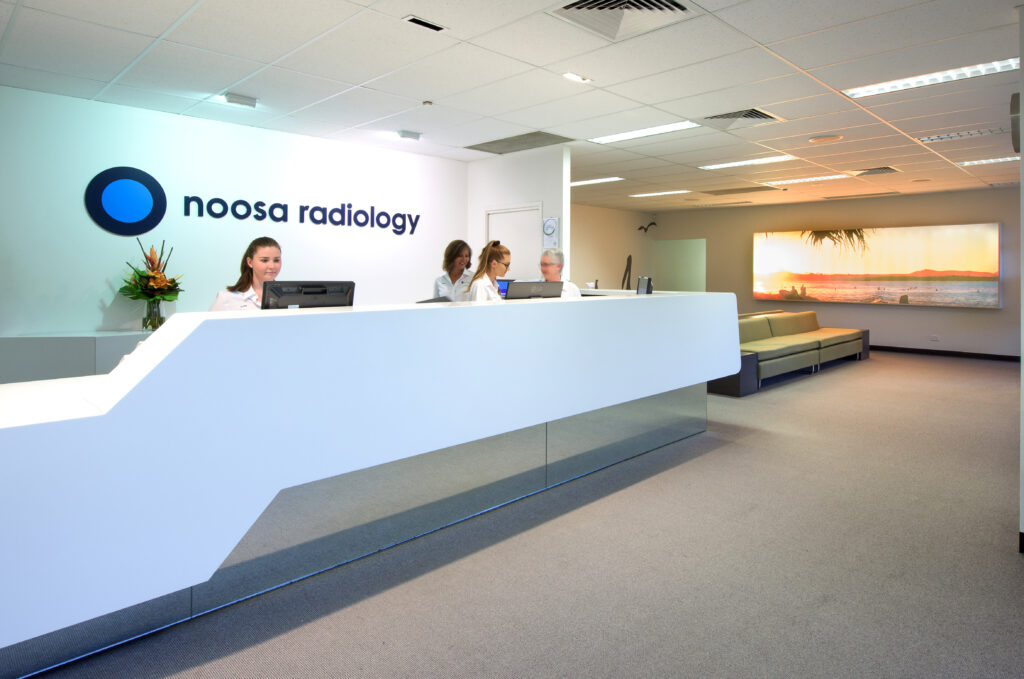Noosa Radiology Media Release

OncoBeta® and Noosa Radiology announce partnership to offer novel treatment for non-melanoma skin cancer on the Sunshine Coast.
OncoBeta®, announces the introduction of its epidermal radioisotope therapy, Rhenium-SCT® for suitable patients with non-melanoma skin cancer (NMSC) at Noosa Radiology in Noosaville.
NMSC represents a significant health concern in Australia, with an incidence five times higher than that of all other cancers combined.1 Medicare reported over 420,000 NMSC treatments in 2023 for Queensland, yet a recent survey revealed that 29% of Australians had never had a professional skin check.2,3With this in mind, OncoBeta developed the painless,†4,5 single-session,‡5,6 radioisotope therapy for NMSC.4,5,7Available at specialist clinics, Rhenium-SCT is administered as a topical application designed to effectively treat lesions‡ whilst minimising damage to surrounding tissue.5,6 This makes it a suitable option for tumours in areas that are cosmetically or functionally sensitive and for patients where other treatments may have failed.5,6
Treatment options for NMSC typically include surgery, conventional radiation therapy, cryotherapy, or ablation.6 Although surgical intervention is an appropriate treatment for many invasive tumours, it may cause disfiguring scarring, complications, require significant downtime, and negatively affect quality of life.8 OncoBeta’s Rhenium-SCT may offer an alternative for patients for whom a nonsurgical option is preferred or required.5

Almost 70% of Australians are projected to need at least one non-melanoma skin cancer (NMSC) removed during their lifetime. 9 As a result, it’s crucial to offer effective alternative treatments for those who may not be eligible for surgery, ensuring the best possible experience for patients.
Dr. Drew McMenamin, Managing Radiologist at Noosa Radiology, is excited to be able to facilitate Rhenium-SCT for Specialists and GPs. Noosa Radiology is proud to be able to extend and build on our nuclear imaging services. Our staff are excited to be working with skin specialists to provide this innovative treatment for patients in our community who may not be suited for traditional therapies
Dr Sid Baxi, APAC Medical Director of OncoBeta®, highlights the need for addressing the significant health concern of NSMC in Queensland: “OncoBeta’s epidermal radioisotope therapy comes in the form of a paste that can be carefully applied to intricate areas like the nose, ears, or lips, providing patients with a non-invasive* option to surgery while achieving outstanding cosmetic results.5,6 Epidermal radioisotope therapy is already well-established in Europe and South Africa, and we are dedicated to improving access for patients in Australia. The launch of this therapy at Noosa Radiology highlights OncoBeta’s commitment to enhancing patient care and broadening treatment options for NMSC.”
About Noosa Radiology
Locally owned and operated, Noosa Radiology is the largest independent radiology clinic providing a comprehensive range of imaging and procedural services to the Noosa and wider Sunshine Coast community in one location.
Established in 2009 by Dr Drew McMenamin, Noosa Radiology is dedicated to delivering the highest standards in medical imaging and patient care.
They are a trusted leader in radiology in their community by combining access to a comprehensive range of radiology services and state-of-the-art technology with a dedicated team of highly skilled radiologists, technical, reception, and administrative staff. Their collaborative approach with referrers aims to optimise communication to promote a seamless and coordinated patient journey to improve patient outcomes.
With the latest in dose reduction technology, Noosa Radiology provides a comprehensive range of imaging and subspeciality imaging services MRI, PET/CT, CT, Nuclear Imaging,Cardiac Imaging, Interventional Radiology, Prostate Imaging, Breast Imaging, Ultrasound, and more. Noosa Radiology offers a comfortable, modern, and professional experience for all who seek its care.
Find out more at www.noosaradiology.com.au
*A treatment is considered non-invasive when no cut or break in the skin is created.10
†No reported pain during procedure.4,5
‡Complete tumour regression in >95% of lesions treated.5,6
References
1. Staples MP, et al. Med J Aust. 2006 Jan 2;184(1):6-10.
2. Australian Government; Services Australia – Medicare Item Reports. Available at: http://medicarestatistics.humanservices.gov.au/statistics/mbs_item.jsp. (Accessed November 2024).
3. TAL SpotChecker Australian Skin Safety Report 2021. Available at: https://www.tal.com.au/-/media/tal/files/spotchecker/tal-spotchecker-australian-skin-safety-report_2021.pdf;
(Accessed November 2024).
4. Cipriani C, et al. International J Nucl Med. 2017; July:114–112.
5. Castellucci P, et al. Eur J Nucl Med Mol Imaging. 2021; 48: 1511–1521.
6. Tietze JK, et al. Clin Nucl Med. 2023;48:869–76.
7. Cipriani C, et al. J Dermatol Treat. 2022;33(2):969–975. Epub 22 Jul 2020.
8. Lee EH, et al. Australas J Dermatol. 2016;57(3):e100-e104.
9. Olsen CM, et al. Public Health Res Pract. 2022;32(1):3212203.